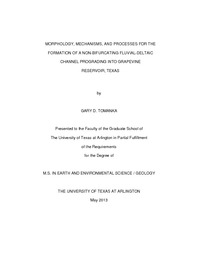
ATTENTION: The works hosted here are being migrated to a new repository that will consolidate resources, improve discoverability, and better show UTA's research impact on the global community. We will update authors as the migration progresses. Please see MavMatrix for more information.
Show simple item record
| dc.contributor.author | Tomanka, Gary D. | en_US |
| dc.date.accessioned | 2013-07-22T20:15:44Z | |
| dc.date.available | 2013-07-22T20:15:44Z | |
| dc.date.issued | 2013-07-22 | |
| dc.date.submitted | January 2013 | en_US |
| dc.identifier.other | DISS-12143 | en_US |
| dc.identifier.uri | http://hdl.handle.net/10106/11903 | |
| dc.description.abstract | Non-bifurcating channels in modern reservoirs, tie channels, and the Mississippi River Bird-Foot Delta share a common morphology that is likely due to an underlying common mechanism. Data analysis indicates that the Denton Creek Delta has prograded into Grapevine Reservoir for 56 years, adhering to the buried pre-impoundment channel without alteration. The hydrodynamic mechanism that controls this adherence is that of a turbulent jet. The properties of the turbulent jet create a dynamic two-phase process, whereby prodelta clays and rare mouth bar sands are eroded while the jet contemporaneously builds sandy levees. An upward tapering channel acts to focus and intensify the jet at less cohesive clays that overlie the preexisting channel. A conceptual model is presented herein comprising basinward tapered levees, the action of the turbulent jet, and rising basin levels which account for the self-sustained progradation of the delta without bifurcation, and result in a distinctive delta morphology. | en_US |
| dc.description.sponsorship | Wickham, John | en_US |
| dc.language.iso | en | en_US |
| dc.publisher | Environmental & Earth Science | en_US |
| dc.title | Morphology, Mechanisms, And Processes For The Formation Of A Non-bifurcating Fluvial-deltaic Channel Prograding Into Grapevine Reservoir, Texas | en_US |
| dc.type | M.S. | en_US |
| dc.contributor.committeeChair | Wickham, John | en_US |
| dc.degree.department | Environmental & Earth Science | en_US |
| dc.degree.discipline | Environmental & Earth Science | en_US |
| dc.degree.grantor | University of Texas at Arlington | en_US |
| dc.degree.level | masters | en_US |
| dc.degree.name | M.S. | en_US |
Files in this item
- Name:
- Tomanka_uta_2502M_12143.pdf
- Size:
- 9.256Mb
- Format:
- PDF
This item appears in the following Collection(s)
Show simple item record


